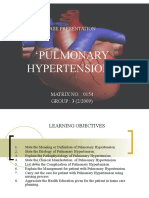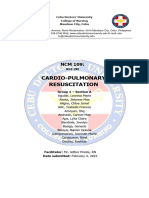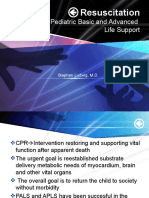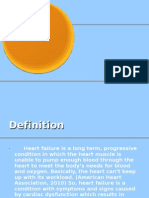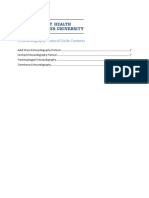Angina Pectoris Pathophysiology
Angina Pectoris Pathophysiology
Uploaded by
Joyce Ann ArenasCopyright:
Available Formats
Angina Pectoris Pathophysiology
Angina Pectoris Pathophysiology
Uploaded by
Joyce Ann ArenasOriginal Description:
Copyright
Available Formats
Share this document
Did you find this document useful?
Is this content inappropriate?
Copyright:
Available Formats
Angina Pectoris Pathophysiology
Angina Pectoris Pathophysiology
Uploaded by
Joyce Ann ArenasCopyright:
Available Formats
Republic of the Philippines
NUEVA ECIJA UNIVERSITY OF SCIENCE AND
Cabanatuan City, Nueva Ecija, Philippines
COLLEGE OF NURSING
NCM 112: ALTERATION IN OXYGENATION
ANGINA PECTORIS
(PATHOPHYSIOLOGY)
SUBMITTED BY:
ARENAS, JOYCE ANN D.
MANAYAO, SAMUEL S.
BSN III-B
SUBMITTED TO:
DIVINA B. OCAMPO, MAN, RN
ACADEMIC INSTRUCTOR
ANATOMY AND PHYSIOLOGY
ISO Transforming Communities through Science and Technology
Telefax No. (044) 463-0226
neustmain@neust.com
9001:2015
Certified www.neust.edu.ph
Republic of the Philippines
NUEVA ECIJA UNIVERSITY OF SCIENCE AND
Cabanatuan City, Nueva Ecija, Philippines
COLLEGE OF NURSING
The primary function of human heart is to
pump blood into the arteries that carries
oxygen and nutrients to all the tissues of
the body. The heart is located in the
center of the chest with its apex toward
the left. It is the hardest working muscle
in the body as it beats non-stop.
How does blood flow through the right
and left side of the heart?
The right and left sides of the heart work
together. The pattern described below is repeated over and over (heart rhythm), causing
blood to flow continuously to the heart, lungs, and body to supply oxygen and nutrients to
the body cells and to deliver waste products to organs that remove them from your body.
In general, veins return blood carrying CO2 while arteries usually contain O2 enriched red
blood cells. However, the blood flow through the heart is a little different. For example:
Right side of the heart
Blood enters the heart through two large veins, the inferior and superior vena cava,
emptying oxygen-poor blood from the body into the right atrium of the heart.
As the atrium contracts, blood flows from your right atrium into your right ventricle
through the open tricuspid valve.
When the ventricle is full, the tricuspid valve shuts. This prevents blood from flowing
backward into the atria while the ventricle contracts.
• As the ventricle contracts, blood leaves the heart through the pulmonic valve, into the
pulmonary artery and to the lungs where it is oxygenated. Note that oxygen-poor or CO2
containing blood goes through the pulmonary artery to the lungs where CO2 is exchanged
for O2.
Left side of the heart (operating at the same time as the right side of the heart)
The pulmonary vein empties oxygen-rich blood from the lungs into the left atrium of the
heart.
As the atrium contracts, blood flows from your left atrium into your left ventricle through
the open mitral valve.
When the ventricle is full, the mitral valve shuts. This prevents blood from flowing
backward into the atrium while the ventricle contracts.
ISO Transforming Communities through Science and Technology
Telefax No. (044) 463-0226
neustmain@neust.com
9001:2015
Certified www.neust.edu.ph
Republic of the Philippines
NUEVA ECIJA UNIVERSITY OF SCIENCE AND
Cabanatuan City, Nueva Ecija, Philippines
COLLEGE OF NURSING
As the ventricle contracts, oxygen-enriched blood leaves the heart through the aortic valve,
into the aorta and to the arteries and eventually into veins to complete the blood
circulation in your body.
How does blood flow through the heart to the lungs?
Once blood travels through the pulmonic valve, it enters your lungs. This is called the
pulmonary circulation.
From your pulmonic valve, blood travels to the pulmonary artery to tiny capillary vessels in
the lungs.
Here, oxygen travels from the tiny air sacs in the lungs, through the walls of the capillaries,
into the blood.
At the same time, carbon dioxide, a waste product of metabolism, passes from the blood
into the air sacs.
Carbon dioxide leaves the body when you exhale.
Once the blood is purified and oxygenated, it travels back to the left atrium through the
pulmonary veins.
ANGINA PECTORIS
Angina is a type of chest pain caused by
reduced blood flow to the heart. Angina
(an-JIE-nuh or AN-juh-nuh) is a symptom
of coronary artery disease.
Angina, also called angina pectoris, is
often described as squeezing, pressure,
heaviness, tightness or pain in your chest.
Symptoms
Angina symptoms include chest pain and discomfort, possibly described as pressure,
squeezing, burning or fullness.
You may also have pain in your arms, neck, jaw, shoulder or back.
Other symptoms that you may have with angina include:
ISO Transforming Communities through Science and Technology
Telefax No. (044) 463-0226
neustmain@neust.com
9001:2015
Certified www.neust.edu.ph
Republic of the Philippines
NUEVA ECIJA UNIVERSITY OF SCIENCE AND
Cabanatuan City, Nueva Ecija, Philippines
COLLEGE OF NURSING
Dizziness
Fatigue
Nausea
Shortness of breath
Sweating
These symptoms need to be evaluated immediately by a doctor who can determine
whether you have stable angina, or unstable angina, which can be a precursor to a heart
attack.
Stable angina is the most common form of angina. It usually happens when you exert
yourself and goes away with rest. For example, pain that comes on when you're walking
uphill or in the cold weather may be angina.
Causes
Angina is caused by reduced blood flow to your heart muscle. Your blood carries oxygen,
which your heart muscle needs to survive. When your heart muscle isn't getting enough
oxygen, it causes a condition called ischemia.
The most common cause of reduced blood flow to your heart muscle is coronary artery
disease (CAD). Your heart (coronary) arteries can become narrowed by fatty deposits
called plaques. This is called atherosclerosis.
During times of low oxygen demand — when you're resting, for example — your heart
muscle may still be able to function on the reduced amount of blood flow without
triggering angina symptoms. But when you increase the demand for oxygen, such as when
you exercise, angina can result.
There are three types of angina:
Stable angina is the most common type. It happens when the heart is working harder than
usual. Stable angina has a regular pattern. Rest and medicines usually help.
Stable angina. Stable angina is usually triggered by physical activity. When you climb stairs,
exercise or walk, your heart demands more blood, but narrowed arteries slow down blood
flow. Besides physical activity, other factors such as emotional stress, cold temperatures,
heavy meals and smoking also can narrow arteries and trigger angina.
ISO Transforming Communities through Science and Technology
Telefax No. (044) 463-0226
neustmain@neust.com
9001:2015
Certified www.neust.edu.ph
Republic of the Philippines
NUEVA ECIJA UNIVERSITY OF SCIENCE AND
Cabanatuan City, Nueva Ecija, Philippines
COLLEGE OF NURSING
Unstable angina is the most dangerous. It does not follow a pattern and can happen without
physical exertion. It does not go away with rest or medicine. It is a sign that you could have
a heart attack soon.
Unstable angina. If fatty deposits (plaques) in a blood vessel rupture or a blood clot forms,
it can quickly block or reduce flow through a narrowed artery. This can suddenly and
severely decrease blood flow to your heart muscle. Unstable angina can also be caused by
blood clots that block or partially block your heart's blood vessels.
Unstable angina worsens and isn't relieved by rest or your usual medications. If the blood
flow doesn't improve, your heart is starved of oxygen and a heart attack occurs. Unstable
angina is dangerous and requires emergency treatment.
Variant angina is rare. It happens when you are resting. Medicines can help.
Prinzmetal's angina. This type of angina is caused by a sudden spasm in a coronary artery,
which temporarily narrows the artery. This narrowing reduces blood flow to your heart,
causing severe chest pain. Prinzmetal's angina most often occurs at rest, typically
overnight. Attacks tend to occur in clusters. Emotional stress, smoking, medications that
tighten blood vessels (such as some migraine drugs) and use of the illegal drug cocaine may
trigger Prinzmetal's angina.
Risk factors
The following risk factors increase your risk of coronary artery disease and angina:
Tobacco use. Chewing tobacco, smoking and long-term exposure to secondhand smoke
damage the interior walls of arteries — including arteries to your heart — allowing
deposits of cholesterol to collect and block blood flow.
Diabetes. Diabetes increases the risk of coronary artery disease, which leads to angina and
heart attacks by speeding up atherosclerosis and increasing your cholesterol levels.
High blood pressure. Over time, high blood pressure damages arteries by accelerating
hardening of the arteries.
High blood cholesterol or triglyceride levels. Cholesterol is a major part of the deposits that
can narrow arteries throughout your body, including those that supply your heart. A high
level of low-density lipoprotein (LDL) cholesterol, also known as "bad" cholesterol,
increases your risk of angina and heart attacks. A high level of triglycerides, a type of blood
fat related to your diet, also is unhealthy.
Family history of heart disease. If a family member has coronary artery disease or has had a
heart attack, you're at a greater risk of developing angina.
Older age. Men older than 45 and women older than 55 have a greater risk than do younger
adults.
ISO Transforming Communities through Science and Technology
Telefax No. (044) 463-0226
neustmain@neust.com
9001:2015
Certified www.neust.edu.ph
Republic of the Philippines
NUEVA ECIJA UNIVERSITY OF SCIENCE AND
Cabanatuan City, Nueva Ecija, Philippines
COLLEGE OF NURSING
Lack of exercise. An inactive lifestyle contributes to high cholesterol, high blood pressure,
type 2 diabetes and obesity. However, it is important to talk with your doctor before
starting an exercise program.
Obesity. Obesity is linked with high blood cholesterol levels, high blood pressure and
diabetes, all which increase your risk of angina and heart disease. If you're overweight,
your heart has to work harder to supply blood to the body.
Stress. Stress can increase your risk of angina and heart attacks. Too much stress, as well as
anger, also can raise your blood pressure. Surges of hormones produced during stress can
narrow your arteries and worsen angina.
Diagnosis
To diagnose angina, your doctor will start by doing a physical exam and asking about your
symptoms. You'll also be asked about any risk factors, including whether you have a family
history of heart disease.
There are several tests your doctor may order to help confirm whether you have angina:
Electrocardiogram (ECG or EKG). Each beat of your heart is triggered by an electrical
impulse generated from special cells in your heart. An electrocardiogram records these
electrical signals as they travel through your heart. Your doctor can look for patterns
among these heartbeats to see if the blood flow through your heart has been slowed or
interrupted or if you're having a heart attack.
Stress test. Sometimes angina is easier to diagnose when your heart is working harder.
During a stress test, you exercise by walking on a treadmill or pedaling a stationary bicycle.
Your blood pressure and ECG readings are monitored as you exercise. Other tests also may
be done at the same time as a stress test. If you're unable to exercise, you may be given
drugs that cause your heart to work harder to simulate exercising followed by an imaging
test.
Echocardiogram. An echocardiogram uses sound waves to produce images of the heart.
Your doctor can use these images to identify angina-related problems, including heart
muscle damage due to poor blood flow. An echocardiogram can be given during a stress
test, and this can show if there are areas of your heart that are not getting enough blood.
Nuclear stress test. A nuclear stress test helps measure blood flow to your heart muscle at
rest and during stress. It is similar to a routine stress test, but during a nuclear stress test, a
radioactive substance is injected into your bloodstream.
ISO Transforming Communities through Science and Technology
Telefax No. (044) 463-0226
neustmain@neust.com
9001:2015
Certified www.neust.edu.ph
Republic of the Philippines
NUEVA ECIJA UNIVERSITY OF SCIENCE AND
Cabanatuan City, Nueva Ecija, Philippines
COLLEGE OF NURSING
This substance mixes with your blood and travels to your heart. A special scanner — which
detects the radioactive material in your heart — shows how the substance moves with the
blood in your heart muscle. Poor blood flow to any part of your heart can be seen on the
images because not as much of the radioactive substance is getting there.
Chest X-ray. This test takes images of your heart and lungs. This is to look for other
conditions that might explain your symptoms and to see if you have an enlarged heart.
Blood tests. Certain heart enzymes slowly leak out into your blood if your heart has been
damaged by a heart attack. Samples of your blood can be tested for the presence of these
enzymes.
Coronary angiography. Coronary angiography uses X-ray imaging to examine the inside of
your heart's blood vessels. It's part of a general group of procedures known as cardiac
catheterization.
During coronary angiography, a type of dye that's visible by X-ray machine is injected into
the blood vessels of your heart. The X-ray machine rapidly takes a series of images
(angiograms), offering a detailed look at the inside of your blood vessels.
Cardiac computerized tomography (CT) scan. In a cardiac CT scan, you lie on a table inside
a doughnut-shaped machine. An X-ray tube inside the machine rotates around your body
and collects images of your heart and chest, which can show if any of your heart's arteries
are narrowed or if your heart is enlarged.
Cardiac MRI. In a cardiac MRI, you lie on a table inside a long, tubelike machine that
produces detailed images of your heart's structure and its blood vessels.
Treatment
There are many options for angina treatment, including lifestyle changes, medications,
angioplasty and stenting, or coronary bypass surgery. The goals of treatment are to reduce
the frequency and severity of your symptoms and to lower your risk of a heart attack and
death.
However, if you have unstable angina or angina pain that's different from what you usually
have, such as occurring when you're at rest, you need immediate treatment in a hospital.
Medications
ISO Transforming Communities through Science and Technology
Telefax No. (044) 463-0226
neustmain@neust.com
9001:2015
Certified www.neust.edu.ph
Republic of the Philippines
NUEVA ECIJA UNIVERSITY OF SCIENCE AND
Cabanatuan City, Nueva Ecija, Philippines
COLLEGE OF NURSING
If lifestyle changes alone don't help your angina, you may need to take medications. These
may include:
Nitrates. Nitrates are often used to treat angina. Nitrates relax and widen your blood
vessels, allowing more blood to flow to your heart muscle. You might take a nitrate when
you have angina-related chest discomfort, before doing something that normally triggers
angina (such as physical exertion) or on a long-term preventive basis. The most common
form of nitrate used to treat angina is nitroglycerin tablets, which you put under your
tongue.
Aspirin. Aspirin reduces the ability of your blood to clot, making it easier for blood to flow
through narrowed heart arteries. Preventing blood clots can also reduce your risk of a
heart attack. But don't start taking a daily aspirin without talking to your doctor first.
Clot-preventing drugs. Certain medications such as clopidogrel (Plavix), prasugrel (Effient)
and ticagrelor (Brilinta) can help prevent blood clots from forming by making your blood
platelets less likely to stick together. One of these medications may be recommended if you
can't take aspirin.
Beta blockers. Beta blockers work by blocking the effects of the hormone epinephrine, also
known as adrenaline. As a result, the heart beats more slowly and with less force, thereby
reducing blood pressure. Beta blockers also help blood vessels relax and open up to
improve blood flow, thus reducing or preventing angina.
Statins. Statins are drugs used to lower blood cholesterol. They work by blocking a
substance your body needs to make cholesterol. They may also help your body reabsorb
cholesterol that has accumulated in plaques in your artery walls, helping prevent further
blockage in your blood vessels. Statins also have many other beneficial effects on your
heart arteries.
Calcium channel blockers. Calcium channel blockers, also called calcium antagonists, relax
and widen blood vessels by affecting the muscle cells in the arterial walls. This increases
blood flow in your heart, reducing or preventing angina.
Blood pressure-lowering medications. If you have high blood pressure, diabetes, signs of
heart failure or chronic kidney disease, your doctor will likely prescribe a medication to
lower your blood pressure. There are two main classes of drugs to treat blood pressure:
angiotensin-converting enzyme (ACE) inhibitors or angiotensin II receptor blockers
(ARBs).
Ranolazine (Ranexa). Ranexa can be used alone or with other angina medications, such as
calcium channel blockers, beta blockers or nitroglycerin.
Medical procedures and surgery
Lifestyle changes and medications are frequently used to treat stable angina. But medical
procedures such as angioplasty, stenting and coronary artery bypass surgery may also be
used to treat angina.
ISO Transforming Communities through Science and Technology
Telefax No. (044) 463-0226
neustmain@neust.com
9001:2015
Certified www.neust.edu.ph
Republic of the Philippines
NUEVA ECIJA UNIVERSITY OF SCIENCE AND
Cabanatuan City, Nueva Ecija, Philippines
COLLEGE OF NURSING
Angioplasty and stenting. During an angioplasty — also called a percutaneous coronary
intervention (PCI) — a tiny balloon is inserted into your narrowed artery. The balloon is
inflated to widen the artery, and then a small wire mesh coil (stent) is usually inserted to
keep the artery open.
This procedure improves blood flow in your heart, reducing or eliminating angina.
Angioplasty and stenting is a good treatment option if you have unstable angina or if
lifestyle changes and medications don't effectively treat your chronic, stable angina.
Coronary artery bypass surgery. During coronary artery bypass surgery, a vein or artery
from somewhere else in your body is used to bypass a blocked or narrowed heart artery.
Bypass surgery increases blood flow to your heart and reduces or eliminates angina. It's a
treatment option for both unstable angina as well as stable angina that has not responded
to other treatments.
External counterpulsation (ECP). With ECP, blood pressure-type cuffs are placed around
the calves, thighs and pelvis to increase blood flow to the heart. ECP requires multiple
treatment sessions. The American College of Cardiology, American Heart Association and
other heart organizations say ECP may help reduce symptoms in people with refractory
angina.
Lifestyle and home remedies
Because heart disease is often the cause of angina, you can reduce or prevent angina by
working on reducing your heart disease risk factors. Making lifestyle changes is the most
important step you can take.
If you smoke, stop smoking. Avoid exposure to secondhand smoke.
If you're overweight, talk to your doctor about weight-loss options.
Eat a healthy diet with limited amounts of saturated fat, lots of whole grains, and many
fruits and vegetables.
Talk to your doctor about starting a safe exercise plan.
Because angina is often brought on by exertion, it's helpful to pace yourself and take rest
breaks.
Treat diseases or conditions that can increase your risk of angina, such as diabetes, high
blood pressure and high blood cholesterol.
Avoid large meals that make you feel overly full.
ISO Transforming Communities through Science and Technology
Telefax No. (044) 463-0226
neustmain@neust.com
9001:2015
Certified www.neust.edu.ph
Republic of the Philippines
NUEVA ECIJA UNIVERSITY OF SCIENCE AND
Cabanatuan City, Nueva Ecija, Philippines
COLLEGE OF NURSING
Avoiding stress is easier said than done, but try to find ways to relax. Talk with your doctor
about stress-reduction techniques.
Limit alcohol consumption to two drinks or fewer a day for men, and one drink a day or
less for women.
Pathophysiology of Angina Pectoris
MODIFIABLE FACTORS NON-MODIFIABLE FACTORS
Tobacco use Family history of heart
High blood cholesterol or disease
triglyceride levels. Diabetes
High blood pressure
Lack of exercise.
Older age
Obesity
Stress
ISO Transforming Communities through Science and Technology
Telefax No. (044) 463-0226
neustmain@neust.com
9001:2015
Certified www.neust.edu.ph
Republic of the Philippines
NUEVA ECIJA UNIVERSITY OF SCIENCE AND
Cabanatuan City, Nueva Ecija, Philippines
COLLEGE OF NURSING
Due to atherosclerotic disease
Increased oxygen demand in the body
Increased heart workload
The heart needs more blood supply
Then coronary artery dilates and supply more blood
to the heart
But due to any factors, blood supply defected
Decreases oxygen level in the heart and
develop condition of ischemia
Starts angina (pain) in pectoris
(chest muscles)
References:
https://www.medicinenet.com/heart_how_the_heart_works/article.htm
https://www.acls.net/anatomy-of-the-human-heart.htm
ISO Transforming Communities through Science and Technology
Telefax No. (044) 463-0226
neustmain@neust.com
9001:2015
Certified www.neust.edu.ph
Republic of the Philippines
NUEVA ECIJA UNIVERSITY OF SCIENCE AND
Cabanatuan City, Nueva Ecija, Philippines
COLLEGE OF NURSING
https://www.mayoclinic.org/diseases-conditions/angina/symptoms-causes/syc-
20369373
https://medlineplus.gov/angina.html
https://www.mayoclinic.org/diseases-conditions/angina/diagnosis-treatment/drc-
20369378
ISO Transforming Communities through Science and Technology
Telefax No. (044) 463-0226
neustmain@neust.com
9001:2015
Certified www.neust.edu.ph
You might also like
- Prometric Exam 3rd EditionDocument1,246 pagesPrometric Exam 3rd Editionasma .sassi82% (11)
- Braunwald's Heart Disease 12th - Nuclear CardiologyDocument46 pagesBraunwald's Heart Disease 12th - Nuclear CardiologyNyoman Ririn Chandrika Sari100% (1)
- Form Ssa 454 BK FREEDocument14 pagesForm Ssa 454 BK FREEDicky keyNo ratings yet
- 4.15.11 RBM ReportDocument27 pages4.15.11 RBM ReportJim PenceNo ratings yet
- PIGS HEART DOCUMENTATION Group3Document4 pagesPIGS HEART DOCUMENTATION Group3Karl EnocNo ratings yet
- Respiratory Failure S/T HCAPDocument50 pagesRespiratory Failure S/T HCAPElaine Jean UayanNo ratings yet
- Pulmonary Hypertension ': Case PresentationDocument64 pagesPulmonary Hypertension ': Case PresentationYasha IchirouNo ratings yet
- Unit 1 - VocabularyDocument2 pagesUnit 1 - VocabularyAnonymous Wfl201YbYoNo ratings yet
- Atrial Septal DefectDocument15 pagesAtrial Septal DefectPatrickNo ratings yet
- Prevention: Blood Pressure Body Weight Here BMIDocument8 pagesPrevention: Blood Pressure Body Weight Here BMILuthfi Rama MaulanaNo ratings yet
- Introduction To Chinese MedicineDocument157 pagesIntroduction To Chinese MedicineAmaliyah RohmahNo ratings yet
- LP Q1. Science9 w2Document9 pagesLP Q1. Science9 w2Christy BetitaNo ratings yet
- Ascvd CSDocument13 pagesAscvd CSGlenn ConcepcionNo ratings yet
- Anatomy of The Heart: Epicardium Myocardium EndocardiumDocument8 pagesAnatomy of The Heart: Epicardium Myocardium EndocardiumTrishna ShahNo ratings yet
- Auricular Acupuncture 2013 SummerDocument89 pagesAuricular Acupuncture 2013 Summerdoringrama100% (3)
- AnaPhy Rot. 5johnDocument2 pagesAnaPhy Rot. 5johnJohn Emmanuel RevilNo ratings yet
- Ai Chi - Meridians1Document7 pagesAi Chi - Meridians1sale18100% (1)
- Assignment On Chest PhysiotherapyDocument15 pagesAssignment On Chest PhysiotherapyAxsa AlexNo ratings yet
- LP Asfiksia Bahasa Inggris RevisiDocument16 pagesLP Asfiksia Bahasa Inggris RevisiErvina AprilianaNo ratings yet
- Birth AsphyxiaDocument7 pagesBirth AsphyxiaAmy LalringhluaniNo ratings yet
- Circulatory system (2)Document41 pagesCirculatory system (2)Mobeen NasirNo ratings yet
- The Theory of Traditional Chinese MedicineDocument4 pagesThe Theory of Traditional Chinese MedicineEric Chambers100% (1)
- Respiratory gymnastics (Translated): Purification - Health - Strength - EnergyFrom EverandRespiratory gymnastics (Translated): Purification - Health - Strength - EnergyNo ratings yet
- Reding and Grammar Exercise 4.Document6 pagesReding and Grammar Exercise 4.Johana Dellaneira Aucancela RamosNo ratings yet
- HM18403 Medical Terminilogy Study Material Up To 4 UnitsDocument48 pagesHM18403 Medical Terminilogy Study Material Up To 4 Unitsanand singhNo ratings yet
- Client ProfileDocument17 pagesClient ProfilekyleaarontulioNo ratings yet
- Health Assessment BSN 1-Ruby: SUBMITTED TO: Miss Rossini Birad SUBMITTED BY: Shandy PansaDocument7 pagesHealth Assessment BSN 1-Ruby: SUBMITTED TO: Miss Rossini Birad SUBMITTED BY: Shandy PansaShan DyNo ratings yet
- 2M Cardio Pulmonary ResuscitationDocument19 pages2M Cardio Pulmonary ResuscitationJason Matthew ImpasNo ratings yet
- CHF Case Study (Document35 pagesCHF Case Study (EzraManzanoNo ratings yet
- Transport in AnimaliaDocument7 pagesTransport in AnimaliawhckaundaNo ratings yet
- Kelompok 15 Modul 2Document27 pagesKelompok 15 Modul 2Yusril DjibranNo ratings yet
- BiologyDocument3 pagesBiologyayanshcafeNo ratings yet
- Case Study: Chronic BronchitisDocument9 pagesCase Study: Chronic BronchitisDivine ParagasNo ratings yet
- Swaiso1 HandoutDocument4 pagesSwaiso1 HandoutVrajesh ShahNo ratings yet
- Resuscitation: Pediatric Basic and Advanced Life SupportDocument51 pagesResuscitation: Pediatric Basic and Advanced Life SupportHeru SetiawanNo ratings yet
- Presented To: Mr. Prince Rener Pera, RN, Emt, MSNDocument19 pagesPresented To: Mr. Prince Rener Pera, RN, Emt, MSNAyesha Mae Baniaga DoctoleroNo ratings yet
- Rheumatic FeverDocument12 pagesRheumatic FeverkeikoV100% (2)
- Cardiovascular and Respiratory SystemDocument57 pagesCardiovascular and Respiratory Systempedrajaskent625No ratings yet
- The Respiratory System: By: Carter Paquette, Ethan Eldridge, Brendan Marusiak, Nik BradingDocument15 pagesThe Respiratory System: By: Carter Paquette, Ethan Eldridge, Brendan Marusiak, Nik BradingJunje HbbNo ratings yet
- Seventh Grade Circulatory SystemDocument8 pagesSeventh Grade Circulatory SystemCarlo MakilingNo ratings yet
- 111111111Document1 page111111111huutribmt54No ratings yet
- Chest PainDocument4 pagesChest PainRosmyn MistychaNo ratings yet
- SIN Module IDocument4 pagesSIN Module IMeiane Ngojo MohamadNo ratings yet
- NCM 118 L 3rd ExamDocument3 pagesNCM 118 L 3rd Examj UNo ratings yet
- Pedia Worksheet 1Document8 pagesPedia Worksheet 1Carlos Miguel AndalNo ratings yet
- Myocardial InfacDocument34 pagesMyocardial InfacWindelyn GamaroNo ratings yet
- 07 - 01 - Assessment of Cardiovascular SystemDocument55 pages07 - 01 - Assessment of Cardiovascular SystemSalman Habeeb50% (2)
- Transport in Animals BIOLOGY bySATRIADocument7 pagesTransport in Animals BIOLOGY bySATRIASatria HalimNo ratings yet
- 23 Veterinary AcupunctureDocument9 pages23 Veterinary AcupunctureRosa Perea BullónNo ratings yet
- DR Amsalu Bekele Ass - Professor of Medicine Head of Chest Unit Department of Internal Medicine Addis Ababa University, School of Medicine Addis Ababa, EthiopiaDocument81 pagesDR Amsalu Bekele Ass - Professor of Medicine Head of Chest Unit Department of Internal Medicine Addis Ababa University, School of Medicine Addis Ababa, EthiopiaBethelhem BirhanuNo ratings yet
- Pathfit 1topicsDocument5 pagesPathfit 1topicsWhoknowsNo ratings yet
- The Human Heart: Learning Activity Sheets inDocument8 pagesThe Human Heart: Learning Activity Sheets inIan RoldanNo ratings yet
- Activity 2 - Group 5 PDFDocument22 pagesActivity 2 - Group 5 PDFJoyce MendozaNo ratings yet
- Angina PectorisDocument20 pagesAngina PectorisJyoti singhNo ratings yet
- UNP TemplateDocument11 pagesUNP TemplateGil CorpuzNo ratings yet
- Respiratory System: VocabularyDocument4 pagesRespiratory System: VocabularyFely NatadNo ratings yet
- Breath Taking: The Power, Fragility, and Future of Our Extraordinary LungsFrom EverandBreath Taking: The Power, Fragility, and Future of Our Extraordinary LungsRating: 3.5 out of 5 stars3.5/5 (5)
- Respiratory SystemDocument341 pagesRespiratory SystemSydney PellosisNo ratings yet
- Activity No. 3, Cardiovascular Sys.Document3 pagesActivity No. 3, Cardiovascular Sys.Mariel CaylanNo ratings yet
- Edema 1Document17 pagesEdema 15130022050No ratings yet
- Bronchial AsthmaDocument71 pagesBronchial AsthmaQuolette Constante100% (1)
- Unit Human Respiratory & Circulatory System Class NotesDocument4 pagesUnit Human Respiratory & Circulatory System Class NotesAiza SulemanNo ratings yet
- Case Study3Document13 pagesCase Study3Nadine FormaranNo ratings yet
- Heart FaliurDocument18 pagesHeart Faliurdp2711No ratings yet
- CHISON SonoBook 9 IntroductionDocument47 pagesCHISON SonoBook 9 IntroductionJose MuñozNo ratings yet
- Cardiac Stress TestingDocument41 pagesCardiac Stress TestingHemant BoolaniNo ratings yet
- 10.1007@s10554 020 01913 6Document10 pages10.1007@s10554 020 01913 6Bosman AriestaNo ratings yet
- Meta Control 3000 Brochure ENGLISHDocument2 pagesMeta Control 3000 Brochure ENGLISHNguyễn Thu ThủyNo ratings yet
- Medical Supplies - English Vocabulary: Term MeaningDocument16 pagesMedical Supplies - English Vocabulary: Term MeaningedonaNo ratings yet
- Turning Images Into Answers: Philips QLAB 10 Cardiac and Vascular Ultrasound Quantification SoftwareDocument12 pagesTurning Images Into Answers: Philips QLAB 10 Cardiac and Vascular Ultrasound Quantification SoftwareS Ram KishoreNo ratings yet
- Reading The Holter ECG ReportDocument50 pagesReading The Holter ECG ReportGreta Tanushi KukaNo ratings yet
- Echo Protocol GuideDocument29 pagesEcho Protocol Guideapi-722001988No ratings yet
- Interview Questions - Valerie RamosDocument3 pagesInterview Questions - Valerie Ramosapi-277297976No ratings yet
- Case Study For Acute Coronary SyndromeDocument7 pagesCase Study For Acute Coronary SyndromeGabbii CincoNo ratings yet
- Journal of Learning InsightsDocument12 pagesJournal of Learning InsightsJisel-Apple Bulan100% (2)
- Khadija Zainab SRS FinalDocument30 pagesKhadija Zainab SRS FinalkhadijawhasNo ratings yet
- Exercise Stress Test Protocol PDFDocument2 pagesExercise Stress Test Protocol PDFYunguoNo ratings yet
- Evaluation and Management of Chronic Thromboembolic Pulmonary HypertensionDocument21 pagesEvaluation and Management of Chronic Thromboembolic Pulmonary HypertensionAndrés MontalvoNo ratings yet
- Introduction To Exercise PrescriptionDocument46 pagesIntroduction To Exercise PrescriptionabhijeetNo ratings yet
- Cardiopulmonary Exercise Testing (CPET)Document2 pagesCardiopulmonary Exercise Testing (CPET)frandi wirajaya100% (1)
- 15) Stable AnginaDocument3 pages15) Stable AnginaAris PaparisNo ratings yet
- Mitral Valve Prolapse (MVP) : Auscultation of MurmursDocument55 pagesMitral Valve Prolapse (MVP) : Auscultation of MurmursYagyeshNo ratings yet
- Risk Stratification in CVD Prevention: How To Identify Cardiovascular Risk in The OfficeDocument28 pagesRisk Stratification in CVD Prevention: How To Identify Cardiovascular Risk in The OfficeJuwanto Wakimin100% (1)
- Chapter-5 General Profile of Corporate Hospitals: Mission and VisionDocument36 pagesChapter-5 General Profile of Corporate Hospitals: Mission and VisionSagar DaniNo ratings yet
- Coronary Artery Disease - Cardiovascular Medicine - MKSAP 17Document18 pagesCoronary Artery Disease - Cardiovascular Medicine - MKSAP 17alaaNo ratings yet
- 040-444 ACSM Registered Clinical Exercise PhysiologistDocument101 pages040-444 ACSM Registered Clinical Exercise PhysiologistKamran Musa100% (1)
- PED 028 Module in Word File RevisedDocument107 pagesPED 028 Module in Word File RevisedKey Mark TarapeNo ratings yet
- Diagnostic Tools in CardiologyDocument77 pagesDiagnostic Tools in Cardiologyphtp7zxs5nNo ratings yet
- Instrumental Diagnostic Methods of Heart DiseasesDocument15 pagesInstrumental Diagnostic Methods of Heart DiseasesA A D H INo ratings yet







